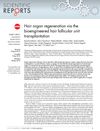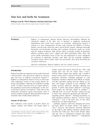Analysis of Female Pattern Hair Loss
April 2019
in “
Journal of emerging technologies and innovative research
”

TLDR Early treatment of Female Pattern Hair Loss is important to stop it from getting worse, and various treatments can help, especially in mild to moderate cases.
The document from April 2019 examines Female Pattern Hair Loss (FPHL), emphasizing the need for early diagnosis and treatment to prevent progression rather than to regrow hair. Diagnosis is primarily clinical, with scalp biopsy rarely needed, and women with hyperandrogenic symptoms should be checked for ovarian or adrenal disorders. Treatments include oral anti-androgens like cyproterone acetate and spironolactone, and topical minoxidil, which are effective in mild to moderate cases. The document notes that FPHL prevalence varies and increases with age, affecting up to 38% of women in some groups. It also explores the potential role of androgens and other factors in FPHL pathophysiology. Various treatments are discussed, including dutasteride, which showed significant improvement in 60% of cases at 1 year and 80% at 2 years, but is not recommended for women of childbearing age not using contraception or with liver impairment. A 12-month study with 66 women found cyproterone acetate more effective than Minoxidil 2% for women with hyper-androgen symptoms. Spironolactone has limited studies but one suggested it was as effective as cyproterone acetate. Low-dose oral Minoxidil is an alternative for those intolerant to the topical form. Nutritional supplements and hair transplantation are other options, though more research is needed for effective therapies.












